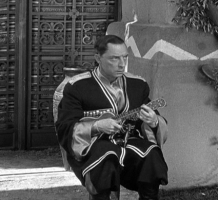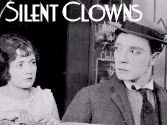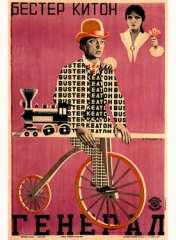 |
ROLL ON
AT COLUMBIA,
Buster Keaton's
Columbia
Two-Reelers |
BUSTER KEATON COLLECTION:
The Great Stone FaceSony has released a 2-DVD set of ten long-unseen short comedies Buster Keaton starred in for Columbia in the late 1930s. All ten shorts look beautiful, and each contains a commentary track from one or more of several Keaton experts. Included also is a 25-minute documentary, featuring most of those same Keaton experts discussing Keaton's career and comic style. All this for a small group of films that were loathed by Keaton himself and considered second-rate by many classic comedy fans.
BUSTER'S LOW YEARS
By the mid-1930s, Buster Keaton, pioneer of silent film comedy, had fallen on hard times. No longer the star he once, considered to be a has-been in the U.S, and with bills to pay, Keaton generally took any movie-related job that came along. This included being a gagman at MGM, starring in a series of cheaply-made shorts at the poverty row studio Educational, and venturing to Europe to appear in a couple of features. So when Columbia approached him in 1939 to star in a comedy series for them, he quickly agreed.
Home to such comics as The Three Stooges and Charley Chase, Columbia was know for turning out cheap two-reel comedies quickly. Producer and director Jules White had one comedy philosophy: keep everything moving fast, so that audiences wouldn't have time to think about whether the films were actually funny. This was the comedy theory, originated by Mack Sennett, that Keaton, Charlie Chaplin and Laurel and Hardy had shattered in the silent years. So Columbia, despite being hospitable to many comics, was not really the best studio for Buster Keaton's style.
Unseen for years, these films have often been dismissed as worthless. Tom Dardis, in his Keaton biography The Man Who Wouldn't Lie Down, barely discusses them, offhandedly describing all ten as "atrocious" without any specifics. One wonders if he even viewed any of them or was just taking his cue from Keaton's own autobiography, My Wonderful World of Slapstick, in which the shorts are described by Keaton himself as "crummy". Even the Sony packaging downplays the contents of the DVDs, using a younger picture of Keaton on the cover and calling it Buster Keaton Collection. You would think maybe a better title might by The Buster Keaton Columbia Shorts, but it is only when you read the back of the box that the contents are actually described. It is as Sony was prodded into releasing these films but hedged their bets with the cover because of their poor reputation.
THE COLUMBIA SHORTS
So are the films any good?
Yes. But the key word is "good". Not "great", "magnificent" or "classic". Merely good, like an average Three Stooges short. Most of them are pleasant time-fillers, fast-moving, featuring plenty of gags and pratfalls. One of them (His Ex Marks the Spot) is so loud, it is annoying. A handful are amusing from beginning to end. All of them star Buster Keaton, who, even in his early forties, was still the greatest physical comedian on the planet. He knew how to fall, when to fall and where to fall. He knew how to make others fall. He knew how to stop the action and focus on a tiny bit of business. In short, Buster Keaton knew comedy, and not even a stylistically mismatched studio like Columbia could stop him from displaying his genius.
Throughout all the films, there are distinct Keatonesque touches. There is a scene in the above-average So You Won't Squawk that has Keaton is entering an office while a gangster is walking out. The gangster sticks his leg out to trip the unaware Keaton. Almost any other comic would have done a spectacular pratfall to get a quick and easy laugh, but Keaton merely hops over the gangster's outstretched leg without even looking at him and goes about his business. It's the kind of subtle gag that was completely out of step with Columbia's house style, and it is a magnificent, though small, triumphant moment for Keaton.
So You Won't Squawk also features several surrealistic gags. Climbing a ladder to string up some light bulbs at a nightclub, Keaton finds himself with one extra bulb and no place to put it. Behind the ladder is a large painting which features among many other things a man holding a tray. Keaton casually places the bulb onto the painted tray --- where it stays in place! It is a wonderful example of how, even in the rushed atmosphere of these shorts, Keaton could occasionally stop time and execute an old-style Keaton gag. There is also a series of strange cartoon-like gags about telephones. These may be impersonal gags that don't spring from character and situations, but they are funny.
NEW STUDIO, NEW TEAM
The films are helped by sympathetic writers. Clyde Bruckman, a Keaton buddy who worked with many great comedians in his life, from Fields to Laurel and Hardy to Abbott and Costello, wrote most of these shorts, with help from Felix Adler, who was a gagman at Hal Roach before joining Columbia. Keaton seemingly had a free hand to add whatever he wanted, and he was not above lifting good material from his old films and recreating them for the new shorts. The plots are standard stuff, featuring gangsters, jealous lovers and all kinds of things you might find in a Three Stooges short. But the plots are not important at all in these films;. Keaton rules the day. Not a single one of the Columbia shorts rises to the level of Keaton's old silent shorts, but most of them are funny without being embarrassing. Several have extended comedy scenes that are mainly silent, showing off Keaton at his best.
 In Pest
from the West, Keaton recreates one of his best routines,
developed originally
for a foreign talkie The
Invader.
Serenading a potential sweetheart with a ukulele and the song "In A
Little Spanish Town", Buster is unaware that the man in the window
above is trying to get some sleep. So at the the end of each
line
of the song, Keaton is pelted with a piece or fruit or crockery from
above. Without giving it all away, I will merely say that it
is a
perfectly executed bit of comedy that proves Buster Keaton
had lost none of his talent or timing. Working at Columbia
may
have been a necessary evil for Keaton, but he wasn't coasting or
slumming. He did his best to make the films funny.
In Pest
from the West, Keaton recreates one of his best routines,
developed originally
for a foreign talkie The
Invader.
Serenading a potential sweetheart with a ukulele and the song "In A
Little Spanish Town", Buster is unaware that the man in the window
above is trying to get some sleep. So at the the end of each
line
of the song, Keaton is pelted with a piece or fruit or crockery from
above. Without giving it all away, I will merely say that it
is a
perfectly executed bit of comedy that proves Buster Keaton
had lost none of his talent or timing. Working at Columbia
may
have been a necessary evil for Keaton, but he wasn't coasting or
slumming. He did his best to make the films funny.
These shorts feature amiable supporting players like pudgy Vernon Dent and cutie Dorothy Appleby, both very familiar to Stooge fans, But it is comedienne Elise Ames who, for better and worse, makes the biggest impression. Prominent in several of these films, Ames is brash, loud, wild, irritating, and energetic to the point of causing exhaustion in the viewer. In The Taming of the Snood, she's like two Jimmy Durantes, both of them full of strong black coffee laced with high-test gasoline. Still, you gotta admire a woman who would run through a room, fling herself across a table and smash headlong into the nearest wall just for a laugh. She seemed to really enjoy working with Keaton and thought nothing of having him manhandle her in the most violent of ways. Ames could take pratfalls with the best of them, and the best of them was, of course, her costar Keaton. On a purely physical level, she worked extremely well with Keaton as a kind of slapstick Ginger Rogers to Keaton's Fred Astaire. She would have been a perfect screenmate for Keaton... if she only knew when to shut up.
HALF A BUSTER BETTER THAN NONE
Don't expect masterpieces like One Week, Cops or The Playhouse with the Columbia shorts. If you do, you will be disappointed. Expect fast-moving, fairly amusing comedies featuring the world's greatest physical clown and you may enjoy yourself. Buster Keaton's golden period was over when the talkies came in, but even in the sound era, Keaton always found ways to be funny. The Columbia shorts are not the best showcases for Keaton's highly personal brand of humor, but they are not the worst either. Buster is still Buster, and that is good enough for a few good solid laughs in each film. - JB
Copyright © John V. Brennan,
2006. All Rights
Reserved.


